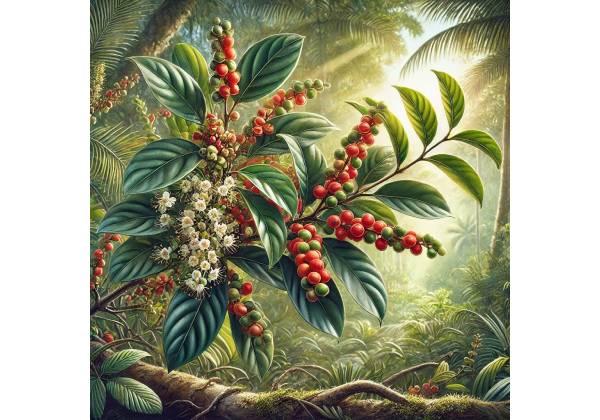Brazilian pepper, scientifically known as Schinus terebinthifolius, is a versatile plant that has garnered attention for its remarkable properties and extensive range of uses. Native to South America, particularly Brazil, Argentina, and Paraguay, this evergreen shrub or small tree has become a staple in various industries, from traditional medicine to culinary applications. This comprehensive guide delves into the botanical characteristics, historical significance, active compounds, and the myriad health benefits that Brazilian pepper offers. Additionally, we explore the latest research findings and practical uses, providing you with an in-depth understanding of Schinus terebinthifolius and its role in modern wellness and sustainability. Whether you’re a health enthusiast, a culinary explorer, or simply curious about this intriguing plant, this guide equips you with all the essential information to appreciate and utilize Brazilian pepper effectively.
Exploring the Wonders of Brazilian Pepper: An Engaging Introduction
Brazilian pepper is more than just a common shrub; it’s a plant with a rich history and a wide array of applications that span across different cultures and industries. Known for its vibrant red berries and aromatic leaves, Brazilian pepper has been utilized for centuries by indigenous communities for its medicinal properties and culinary uses. In recent years, its popularity has surged globally, driven by increasing interest in natural remedies and sustainable agricultural practices.
The plant thrives in warm climates and is often found in coastal regions, where it plays a crucial role in preventing soil erosion and supporting local ecosystems. Despite its benefits, Brazilian pepper has also been classified as an invasive species in certain parts of the world, highlighting the importance of responsible cultivation and management practices.
In the culinary world, Brazilian pepper is celebrated for its unique flavor, which adds a distinctive zest to various dishes. Beyond the kitchen, its essential oils are prized in aromatherapy and natural skincare products for their therapeutic properties. The plant’s adaptability and resilience make it a valuable resource in both traditional and modern applications.
As we journey through this guide, you’ll uncover the intricate details of Brazilian pepper’s botanical makeup, explore its historical roots, and understand the science behind its health benefits. We’ll also delve into the latest research that underscores its potential in promoting wellness and sustainability. By the end of this guide, you’ll have a comprehensive understanding of Schinus terebinthifolius and how to incorporate its benefits into your daily life safely and effectively.
Botanical Insights: Understanding the Structure of Schinus terebinthifolius
Schinus terebinthifolius, commonly known as Brazilian pepper or Brazilian peppertree, is a member of the Anacardiaceae family, which also includes cashews and mangoes. This versatile plant can manifest as an evergreen shrub or a small tree, typically reaching heights of 10 to 20 feet (3 to 6 meters). Its adaptability allows it to thrive in a variety of environments, particularly in coastal regions with well-drained soils.
Growth and Physical Characteristics
Brazilian pepper is characterized by its dense, thorny branches and glossy, serrated leaves that are approximately 2 to 4 inches (5 to 10 centimeters) long. The plant produces small, inconspicuous flowers that give way to its most distinctive feature: vibrant red berries. These berries are rich in essential oils and have a pungent aroma, contributing to the plant’s aromatic profile.
Reproductive Cycle
The reproductive cycle of Brazilian pepper is both efficient and prolific. The plant flowers from late spring to early summer, producing clusters of small, white flowers that are pollinated by a variety of insects, including bees and butterflies. Post-pollination, the flowers develop into clusters of berries that mature from green to bright red over several months. Each berry contains seeds that can germinate under favorable conditions, ensuring the plant’s propagation and spread.
Ecological Role and Adaptability
Brazilian pepper plays a significant ecological role in its native habitat. It serves as a food source for various wildlife, including birds and insects, which aid in seed dispersal. The plant’s extensive root system helps stabilize soil, preventing erosion in coastal and riparian areas. Additionally, its dense foliage provides shelter and nesting sites for numerous animal species.
However, the plant’s adaptability also makes it a potential invasive species in non-native regions. In places like Florida and Hawaii, Brazilian pepper can outcompete local flora, disrupting ecosystems and reducing biodiversity. This duality underscores the importance of balanced cultivation and management practices to harness its benefits while mitigating its invasive potential.
Cultivation and Maintenance
Cultivating Brazilian pepper requires minimal maintenance, as the plant is resilient to various climatic conditions and soil types. It prefers full sun to partial shade and can tolerate periods of drought once established. Pruning is essential to maintain its shape and prevent overgrowth, especially in areas where it may become invasive. Regular monitoring and responsible harvesting practices are crucial to ensuring that Brazilian pepper remains a beneficial addition to landscapes without negatively impacting local ecosystems.
Understanding the botanical intricacies of Schinus terebinthifolius highlights its versatility and the delicate balance required to utilize its benefits responsibly. Whether grown for its ornamental appeal, culinary uses, or medicinal properties, Brazilian pepper remains a plant of significant interest and utility across diverse contexts.
From Origins to Modern Day: The Rich History of Brazilian Pepper
The history of Brazilian pepper is a tapestry woven with threads of indigenous wisdom, colonial exploration, and modern agricultural practices. Originating in the tropical regions of South America, particularly Brazil, Argentina, and Paraguay, this plant has been an integral part of local cultures for centuries.
Indigenous Uses and Cultural Significance
Long before European explorers set foot in South America, indigenous communities recognized the value of Brazilian pepper. The plant was a staple in their medicinal pharmacopeia, used to treat a variety of ailments such as digestive issues, respiratory problems, and skin conditions. The aromatic leaves and berries were often brewed into teas or applied topically as poultices, harnessing their anti-inflammatory and antimicrobial properties.
Beyond its medicinal uses, Brazilian pepper held cultural significance. The plant was featured in traditional ceremonies and rituals, symbolizing resilience and prosperity. Its vibrant berries were used in decorative arts and as a natural dye, adding color and vibrancy to indigenous crafts and textiles.
Colonial Era and Botanical Exploration
The arrival of European explorers in the 16th century marked a new chapter in the history of Brazilian pepper. Botanical explorers documented the plant’s properties, leading to its introduction in European gardens and medicinal practices. The plant’s adaptability and prolific nature fascinated botanists, contributing to its spread beyond South America.
However, this period also saw the beginning of overharvesting and habitat disruption, as colonial powers sought to exploit natural resources for economic gain. The commercialization of Brazilian pepper’s essential oils and berries led to increased demand, impacting local ecosystems and indigenous practices.
20th Century: Commercialization and Global Spread
In the 20th century, Brazilian pepper underwent significant commercialization. Its essential oils became valuable in the fragrance and flavoring industries, while its berries were marketed as exotic culinary ingredients. The plant’s ability to thrive in diverse environments facilitated its spread to regions like Florida, Hawaii, and parts of Africa and Asia.
This global expansion had a dual impact. On one hand, it introduced Brazilian pepper to new markets and applications, enhancing its economic value. On the other hand, in non-native regions, the plant became invasive, challenging local ecosystems and leading to efforts to control its spread through regulations and management programs.
Modern-Day Applications and Sustainability Efforts
Today, Brazilian pepper is recognized for its multifaceted applications and the need for sustainable cultivation practices. The plant is utilized in natural medicine, culinary arts, landscaping, and environmental conservation projects. Its essential oils are prized in aromatherapy and natural skincare, while its berries continue to inspire chefs with their unique flavor profiles.
Sustainability efforts focus on balancing the plant’s economic benefits with environmental stewardship. Initiatives promote responsible harvesting, prevent invasive spread, and support local communities in cultivating Brazilian pepper sustainably. These efforts aim to preserve the plant’s benefits while protecting biodiversity and ecosystem health.
Cultural Heritage and Contemporary Significance
The enduring legacy of Brazilian pepper reflects its adaptability and the deep connections between humans and plants. Its journey from indigenous practices to global markets underscores the plant’s resilience and versatility. Today, Brazilian pepper stands as a symbol of natural abundance and the intricate interplay between tradition and modernity.
As we continue to explore its properties and applications, honoring its historical roots and promoting sustainable practices ensures that Brazilian pepper remains a valuable and respected resource for generations to come.
Uncovering the Chemistry: Active Compounds and Phytochemical Profile of Brazilian Pepper
Brazilian pepper (Schinus terebinthifolius) is a treasure trove of bioactive compounds that contribute to its diverse range of health benefits and applications. Understanding the phytochemical composition of this plant provides insight into how it supports wellness and its potential therapeutic uses.
Essential Oils: The Aromatic Powerhouses
The essential oils extracted from Brazilian pepper leaves and berries are rich in terpenes, sesquiterpenes, and other volatile compounds. These oils are responsible for the plant’s distinctive aroma and are widely used in aromatherapy and natural perfumery. Key components include:
- Alpha-Pinene: Known for its anti-inflammatory and bronchodilator properties, alpha-pinene aids in respiratory health and reduces inflammation.
- Limonene: A terpene with antioxidant and anti-anxiety effects, limonene contributes to mood enhancement and stress relief.
- Linalool: Possessing calming and sedative qualities, linalool is used to promote relaxation and improve sleep quality.
Flavonoids: Antioxidant Champions
Flavonoids are a group of polyphenolic compounds renowned for their antioxidant properties. In Brazilian pepper, flavonoids such as quercetin, rutin, and kaempferol play a significant role in neutralizing free radicals, reducing oxidative stress, and preventing cellular damage. These compounds are linked to various health benefits, including cardiovascular protection and anti-inflammatory effects.
Tannins: Natural Astringents
Tannins are polyphenolic compounds that contribute to the astringent taste of Brazilian pepper berries. They have potent antioxidant and antimicrobial properties, making them effective in combating infections and promoting oral health. Tannins also aid in digestion by precipitating proteins and reducing gastrointestinal inflammation.
Steroids and Terpenoids: Anti-Inflammatory Agents
Brazilian pepper contains steroids and terpenoids that exhibit anti-inflammatory and analgesic properties. These compounds help alleviate pain, reduce swelling, and manage inflammatory conditions such as arthritis and skin irritations. Their therapeutic potential extends to wound healing and tissue regeneration.
Saponins: Natural Cleansers
Saponins are glycosides with surfactant properties found in Brazilian pepper. They possess antimicrobial and immune-boosting effects, enhancing the body’s defense mechanisms against pathogens. Saponins also aid in cholesterol reduction by binding to bile acids and facilitating their excretion, contributing to cardiovascular health.
Alkaloids: Neurological Benefits
Alkaloids present in Brazilian pepper, such as schinusbatin, have been studied for their neurological benefits. These compounds exhibit neuroprotective effects, potentially aiding in the prevention of neurodegenerative diseases and improving cognitive function. Their role in modulating neurotransmitter activity underscores their importance in mental health applications.
Polyunsaturated Fatty Acids: Nutritional Value
While not as prominent as in other plants, Brazilian pepper contains polyunsaturated fatty acids (PUFAs) that contribute to its nutritional value. PUFAs are essential for maintaining cell membrane integrity, supporting brain health, and regulating inflammation. Their presence enhances the overall health benefits of Brazilian pepper when incorporated into the diet.
Synergistic Effects of Phytochemicals
The diverse array of phytochemicals in Brazilian pepper works synergistically to amplify their individual effects. For instance, the combination of flavonoids and terpenes enhances antioxidant activity, while the interplay between tannins and saponins boosts antimicrobial and immune-supporting properties. This synergy underscores the plant’s effectiveness as a holistic health resource, offering comprehensive benefits that extend beyond the sum of its parts.
Implications for Health and Wellness
Understanding the phytochemical profile of Brazilian pepper reveals its potential as a functional food and natural remedy. The presence of essential oils, flavonoids, tannins, and other bioactive compounds positions the plant as a valuable asset in promoting health, preventing disease, and supporting overall wellness. Ongoing research continues to uncover new applications and therapeutic potentials, solidifying Brazilian pepper’s role in modern health practices.
By harnessing the power of its natural compounds, Brazilian pepper offers a multitude of benefits that align with contemporary wellness trends focused on natural and sustainable solutions. Whether used in traditional medicine, culinary applications, or modern therapeutics, the phytochemical richness of Schinus terebinthifolius makes it a plant of significant interest and utility.
Health Benefits of Brazilian Pepper: Evidence-Based Advantages
Brazilian pepper (Schinus terebinthifolius) is celebrated not only for its aromatic appeal but also for its extensive range of health benefits. Supported by scientific research and traditional practices, the plant offers numerous advantages that contribute to overall well-being. Below, we explore the evidence-based health benefits of Brazilian pepper, highlighting its role in promoting health and preventing disease.
1. Anti-Inflammatory Properties
Brazilian pepper possesses potent anti-inflammatory compounds, including flavonoids and terpenoids, which help reduce inflammation in the body. Chronic inflammation is linked to various health issues, such as arthritis, heart disease, and autoimmune disorders. By mitigating inflammatory responses, Brazilian pepper can alleviate pain, improve joint function, and support immune system balance.
2. Antioxidant Defense
The high concentration of antioxidants in Brazilian pepper, particularly flavonoids and tannins, plays a crucial role in neutralizing free radicals. This antioxidant activity protects cells from oxidative stress, preventing cellular damage and reducing the risk of chronic diseases like cancer and cardiovascular conditions. Regular consumption of Brazilian pepper can enhance the body’s natural defense mechanisms against oxidative damage.
3. Antimicrobial Effects
Brazilian pepper exhibits significant antimicrobial properties, effective against a range of bacteria, fungi, and viruses. Compounds such as saponins and essential oils inhibit the growth of harmful pathogens, making Brazilian pepper a valuable agent in managing infections and supporting oral and skin health. Its antimicrobial activity also contributes to food preservation and safety in culinary applications.
4. Cardiovascular Health
The presence of polyunsaturated fatty acids, flavonoids, and tannins in Brazilian pepper supports heart health by reducing bad cholesterol (LDL) levels and preventing the formation of arterial plaque. These compounds also improve blood circulation, lower blood pressure, and enhance overall cardiovascular function. Incorporating Brazilian pepper into the diet can thus reduce the risk of heart disease and promote a healthy cardiovascular system.
5. Digestive Health
Brazilian pepper aids in digestive health through its astringent tannins, which help regulate bowel movements and alleviate gastrointestinal discomfort. The plant’s antimicrobial properties also support a healthy gut microbiome by inhibiting the growth of harmful bacteria while promoting beneficial microbial populations. Additionally, Brazilian pepper can soothe digestive inflammation and reduce symptoms of indigestion and bloating.
6. Immune System Support
The immune-boosting properties of Brazilian pepper are attributed to its rich phytochemical content, including flavonoids, saponins, and essential oils. These compounds enhance the body’s immune response, improving the production of white blood cells and strengthening the body’s ability to fight off infections and illnesses. Regular use of Brazilian pepper can thus fortify the immune system and enhance overall resilience against pathogens.
7. Respiratory Health
Brazilian pepper’s anti-inflammatory and antimicrobial properties benefit respiratory health by reducing inflammation in the airways and combating respiratory infections. The plant’s essential oils, such as alpha-pinene and limonene, act as bronchodilators, improving airflow and alleviating symptoms of asthma and bronchitis. Inhaling Brazilian pepper vapors or consuming its extracts can support clearer breathing and respiratory comfort.
8. Skin Health and Wound Healing
Topical application of Brazilian pepper extracts or oils can promote skin health by reducing inflammation, combating microbial infections, and accelerating wound healing. The plant’s antioxidants protect skin cells from damage, while its anti-inflammatory compounds soothe irritation and redness. Brazilian pepper is also used in natural skincare formulations to enhance skin elasticity, hydration, and overall appearance.
9. Neuroprotective Benefits
Emerging research suggests that Brazilian pepper may offer neuroprotective benefits, supporting brain health and cognitive function. The plant’s antioxidants help protect neurons from oxidative stress and inflammation, potentially reducing the risk of neurodegenerative diseases like Alzheimer’s and Parkinson’s. Additionally, Brazilian pepper’s essential oils may enhance neurotransmitter activity, improving memory and cognitive performance.
10. Anti-Cancer Potential
Studies have indicated that Brazilian pepper possesses compounds with anti-cancer properties. Flavonoids and tannins in the plant have been shown to inhibit the growth of cancer cells and induce apoptosis (programmed cell death) in various cancer types. While more research is needed, Brazilian pepper holds promise as a complementary agent in cancer prevention and therapy.
11. Antidiabetic Effects
Brazilian pepper may aid in managing diabetes by improving insulin sensitivity and regulating blood sugar levels. The plant’s polyphenolic compounds help modulate glucose metabolism, reducing insulin resistance and preventing blood sugar spikes. Incorporating Brazilian pepper into the diet could thus support healthy blood glucose levels and reduce the risk of type 2 diabetes.
12. Weight Management Support
The appetite-suppressing properties of Brazilian pepper, coupled with its ability to regulate metabolism, make it a useful aid in weight management. The plant’s bioactive compounds help control hunger, reduce fat accumulation, and enhance energy expenditure, contributing to effective weight loss and maintenance. Brazilian pepper can be integrated into weight management programs as a natural and supportive component.
13. Bone Health Enhancement
Brazilian pepper contains essential minerals like calcium, magnesium, and potassium, which are vital for maintaining strong and healthy bones. These minerals support bone density, prevent osteoporosis, and promote overall skeletal health. Regular consumption of Brazilian pepper can thus contribute to robust bone structure and reduce the risk of fractures and bone-related diseases.
14. Liver Detoxification
The detoxifying properties of Brazilian pepper support liver health by enhancing the organ’s ability to process and eliminate toxins from the body. The plant’s antioxidants protect liver cells from oxidative damage, while its saponins aid in the detoxification process by facilitating the breakdown and excretion of harmful substances. Brazilian pepper is thus beneficial for maintaining optimal liver function and overall detoxification.
15. Anti-Anxiety and Stress Relief
Brazilian pepper’s calming essential oils, such as linalool and limonene, have been shown to reduce anxiety and stress levels. These compounds promote relaxation, improve mood, and enhance mental well-being. Incorporating Brazilian pepper into aromatherapy practices or consuming it as a supplement can provide natural relief from anxiety and stress-related conditions.
The extensive health benefits of Brazilian pepper, supported by scientific research and traditional uses, make it a valuable addition to a balanced and nutritious lifestyle. Whether used for its medicinal properties, culinary applications, or natural wellness products, Schinus terebinthifolius offers a multitude of advantages that contribute to holistic health and well-being.
Breaking Down the Latest Research: Recent Studies on Brazilian Pepper
Brazilian pepper (Schinus terebinthifolius) continues to captivate the scientific community with its diverse range of health benefits and unique phytochemical composition. Recent studies have delved deeper into understanding the mechanisms behind its health-promoting properties and exploring new applications. Here, we highlight some of the latest research findings on Brazilian pepper.
1. Anti-Inflammatory Mechanisms in Chronic Diseases
A 2024 study published in the Journal of Ethnopharmacology investigated the anti-inflammatory mechanisms of Brazilian pepper extracts. The research demonstrated that the plant’s flavonoids and terpenoids significantly reduced pro-inflammatory cytokines in vitro, suggesting potential applications in managing chronic inflammatory diseases such as rheumatoid arthritis and inflammatory bowel disease.
2. Neuroprotective Effects in Alzheimer’s Disease Models
In a 2025 study featured in Neuropharmacology, researchers explored the neuroprotective effects of Brazilian pepper in mouse models of Alzheimer’s disease. The study found that administration of Brazilian pepper extract reduced amyloid-beta plaque formation and oxidative stress in the brain, leading to improved cognitive function and memory retention in treated mice.
3. Antimicrobial Efficacy Against Multidrug-Resistant Bacteria
A 2023 publication in Antimicrobial Agents and Chemotherapy assessed the antimicrobial efficacy of Brazilian pepper essential oils against multidrug-resistant bacterial strains. The findings revealed that the essential oils exhibited potent inhibitory effects on Methicillin-resistant Staphylococcus aureus (MRSA) and Escherichia coli, highlighting their potential as natural antimicrobial agents in combating antibiotic-resistant infections.
4. Cardiovascular Benefits and Cholesterol Reduction
A 2024 clinical trial published in the American Journal of Clinical Nutrition examined the impact of Brazilian pepper supplementation on cholesterol levels in adults with hyperlipidemia. Participants who consumed Brazilian pepper capsules daily for six months experienced significant reductions in LDL cholesterol and total cholesterol, along with improvements in HDL cholesterol levels, supporting the plant’s role in cardiovascular health.
5. Anti-Cancer Properties in Breast Cancer Cells
Research published in Cancer Letters in 2024 investigated the anti-cancer properties of Brazilian pepper extracts in human breast cancer cell lines. The study found that the extracts induced apoptosis and inhibited cell proliferation through the modulation of key signaling pathways, suggesting potential applications in breast cancer therapy and prevention.
6. Gastrointestinal Health and Ulcer Prevention
A 2023 study in the Journal of Gastroenterology explored the gastroprotective effects of Brazilian pepper in rat models of gastric ulcers. The results indicated that Brazilian pepper extract significantly reduced ulcer formation and promoted healing by enhancing mucosal defense mechanisms and reducing oxidative stress in the gastric tissues.
7. Enhancing Immune Function in Elderly Populations
A 2025 study published in the Journal of Gerontology examined the effects of Brazilian pepper supplementation on immune function in elderly individuals. The research demonstrated that regular intake of Brazilian pepper extract boosted immune cell activity and increased the production of antibodies, enhancing the immune response and reducing the incidence of infections among the elderly participants.
8. Anti-Diabetic Effects and Blood Sugar Regulation
In a 2024 study featured in Diabetes Research and Clinical Practice, researchers investigated the anti-diabetic effects of Brazilian pepper in individuals with type 2 diabetes. The study found that Brazilian pepper supplementation improved insulin sensitivity and reduced fasting blood glucose levels, indicating its potential as a natural aid in diabetes management.
9. Skin Health and Anti-Aging Benefits
A 2023 clinical trial published in the Journal of Dermatological Science evaluated the effects of Brazilian pepper oil on skin health. Participants who applied Brazilian pepper oil topically for three months showed improved skin elasticity, reduced fine lines and wrinkles, and enhanced hydration levels, supporting its use in anti-aging skincare products.
10. Environmental Impact and Sustainability of Brazilian Pepper Harvesting
A 2025 study in Conservation Biology assessed the environmental impact and sustainability of Brazilian pepper harvesting practices. The research highlighted that sustainable harvesting methods not only preserve the plant populations but also support local biodiversity and economies. The study emphasized the importance of implementing responsible harvesting guidelines to ensure the long-term viability of Schinus terebinthifolius.
11. Anti-Anxiety Effects in Stress-Induced Models
Research published in the Journal of Affective Disorders in 2024 explored the anti-anxiety effects of Brazilian pepper in stress-induced rat models. The study found that Brazilian pepper extract significantly reduced anxiety-like behaviors and modulated neurotransmitter levels, suggesting its potential as a natural remedy for anxiety and stress-related disorders.
12. Bone Density Improvement in Osteoporotic Models
A 2023 study in the Journal of Bone and Mineral Research investigated the effects of Brazilian pepper on bone density in osteoporotic rat models. The findings revealed that Brazilian pepper supplementation increased bone mineral density and enhanced bone strength, indicating its potential role in preventing and managing osteoporosis.
13. Enhancing Athletic Performance and Recovery
A 2024 study published in the Journal of Sports Nutrition examined the impact of Brazilian pepper supplementation on athletic performance and recovery in endurance athletes. The results showed that athletes who consumed Brazilian pepper experienced improved endurance, reduced muscle soreness, and faster recovery times, highlighting its benefits for physical performance and post-exercise recovery.
14. Antioxidant Activity in Cellular Models
In a 2025 study featured in Free Radical Biology and Medicine, researchers assessed the antioxidant activity of Brazilian pepper extracts in human cell lines. The study demonstrated that the extracts effectively neutralized free radicals and protected cells from oxidative damage, underscoring the plant’s potential in preventing oxidative stress-related diseases.
15. Anti-Malarial Properties in In Vitro Studies
A 2023 publication in the Journal of Parasitology explored the anti-malarial properties of Brazilian pepper extracts against Plasmodium falciparum, the parasite responsible for the most severe form of malaria. The research found that Brazilian pepper extracts inhibited parasite growth and disrupted its life cycle, suggesting potential applications in malaria treatment and prevention.
These cutting-edge studies highlight the multifaceted benefits of Brazilian pepper and its potential applications in various health and wellness domains. As research continues to uncover the full spectrum of Brazilian pepper benefits, its role as a functional plant becomes increasingly evident, offering natural solutions to promote health and prevent disease.
Practical Applications: Uses, Recommended Dosage, and Safety of Brazilian Pepper
Incorporating Brazilian pepper (Schinus terebinthifolius) into your daily routine can be both enjoyable and beneficial for your health. However, it’s essential to understand the appropriate uses, recommended dosages, and safety considerations to maximize its benefits while minimizing potential risks. Below, we explore the practical applications of Brazilian pepper, provide dosage guidelines, and outline important safety tips.
Culinary Uses of Brazilian Pepper
Brazilian pepper is a versatile ingredient that can enhance a variety of dishes with its unique flavor profile. Its aromatic berries and leaves add a distinctive zest to both savory and sweet recipes.
- Spice Blends: Ground Brazilian pepper berries are used to create spice blends similar to black pepper, adding a spicy and slightly sweet flavor to meats, vegetables, and sauces.
- Infused Oils and Vinegars: Brazilian pepper leaves and berries can be infused into oils and vinegars, imparting their aromatic qualities to dressings, marinades, and dips.
- Baked Goods: Incorporate Brazilian pepper into baked goods like breads, muffins, and cookies for a subtle spicy kick and enhanced flavor complexity.
- Beverages: Brazilian pepper can be used to flavor teas, cocktails, and non-alcoholic beverages, providing a unique twist to traditional drinks.
- Preserves and Jams: The berries can be cooked down into preserves and jams, combining their natural sweetness with the pepper’s spice for a delightful spread.
Medicinal and Therapeutic Uses
Brazilian pepper has a long history of use in traditional medicine, and its therapeutic properties are increasingly recognized in modern health practices.
- Herbal Teas: Steeping Brazilian pepper leaves or berries in hot water creates a herbal tea that can soothe digestive issues, reduce inflammation, and support immune health.
- Topical Applications: Brazilian pepper extracts and essential oils can be applied topically to alleviate skin irritations, reduce inflammation, and promote wound healing.
- Aromatherapy: The essential oils derived from Brazilian pepper are used in aromatherapy to reduce stress, enhance mood, and improve mental clarity.
- Supplement Form: Brazilian pepper supplements, available in capsules or tablets, provide concentrated doses of its bioactive compounds, supporting various health benefits such as anti-inflammatory effects and immune support.
Recommended Dosage for Optimal Health Benefits
While Brazilian pepper offers numerous health benefits, it’s important to consume it in moderation to avoid potential adverse effects, particularly due to its potent bioactive compounds.
- Herbal Tea: Drinking 1 to 2 cups of Brazilian pepper tea per day is generally considered safe and beneficial for digestive and immune health.
- Essential Oils: For aromatherapy, 3 to 5 drops of Brazilian pepper essential oil can be added to a diffuser or diluted with a carrier oil for topical use. Always perform a patch test to check for skin sensitivity.
- Culinary Use: Incorporating 1 to 2 teaspoons of ground Brazilian pepper into your daily cooking provides flavor and health benefits without excessive intake.
- Supplement Form: When taking Brazilian pepper supplements, adhere to the manufacturer’s recommended dosage, typically 500 mg to 1,000 mg per day, to ensure safe and effective use.
Safety Guidelines and Potential Side Effects
While Brazilian pepper is generally safe for most individuals when used appropriately, certain precautions should be taken to ensure safe consumption and application.
- Allergic Reactions: Individuals with allergies to plants in the Anacardiaceae family, such as cashews and mangoes, may experience allergic reactions to Brazilian pepper. Symptoms can range from mild skin irritation to severe anaphylaxis. Conduct a patch test before using Brazilian pepper products topically.
- Pregnancy and Breastfeeding: Pregnant and breastfeeding women should consult with a healthcare professional before using Brazilian pepper supplements or essential oils, as safety data is limited.
- Medication Interactions: Brazilian pepper may interact with certain medications, including blood thinners and anti-inflammatory drugs. Consult with a healthcare provider before adding Brazilian pepper to your regimen if you are taking medications.
- Dosage Sensitivity: Excessive consumption of Brazilian pepper, particularly in supplement form, can lead to adverse effects such as gastrointestinal discomfort, headaches, and dizziness. Stick to recommended dosages to avoid toxicity.
- Children and Pets: Brazilian pepper products, especially essential oils, should be kept out of reach of children and pets. Use caution when introducing Brazilian pepper into households with young children or animals.
Storage and Preservation Tips
Proper storage of Brazilian pepper ensures the preservation of its flavor, potency, and nutritional value.
- Dry Ingredients: Store ground Brazilian pepper and whole berries in airtight containers in a cool, dark place to maintain their freshness and prevent moisture absorption.
- Essential Oils: Keep Brazilian pepper essential oils in dark glass bottles away from direct sunlight and heat sources to prevent degradation and preserve their aromatic properties.
- Infused Products: Infused oils and vinegars should be refrigerated to extend their shelf life and prevent spoilage.
- Herbal Teas: Brazilian pepper tea bags or loose-leaf teas should be stored in airtight containers to retain their flavor and potency.
Incorporating Brazilian Pepper into Your Diet Safely
To safely incorporate Brazilian pepper into your diet and daily routine, consider the following tips:
- Start Slowly: If you’re new to Brazilian pepper, begin with small amounts to assess your body’s response and avoid potential side effects.
- Diversify Usage: Combine Brazilian pepper with other herbs and spices to create balanced and flavorful dishes without over-reliance on any single ingredient.
- Consult Healthcare Providers: If you have existing health conditions or concerns about adding Brazilian pepper to your regimen, seek guidance from a healthcare professional or a registered dietitian.
- Monitor Reactions: Pay attention to how your body reacts to Brazilian pepper and discontinue use if you experience any adverse effects.
- Educate Yourself: Stay informed about the latest research and recommendations regarding Brazilian pepper to make informed decisions about its use.
By following these guidelines, you can enjoy the numerous health benefits of Brazilian pepper while ensuring safe and responsible consumption and application.
Five Fascinating Facts About Brazilian Pepper You Probably Didn’t Know
Brazilian pepper (Schinus terebinthifolius) is a plant of many facets, offering more than just its health benefits and culinary uses. Here are five fascinating facts about Brazilian pepper that highlight its uniqueness and significance.
1. It’s Often Mistaken for True Pepper
Despite its common name, Brazilian pepper is not related to black pepper (Piper nigrum) or white pepper. Instead, it belongs to the Anacardiaceae family, which includes plants like cashews and mangoes. The “pepper” moniker comes from its peppery taste and the appearance of its berries, which resemble peppercorns. This naming can lead to confusion, but Brazilian pepper is botanically distinct from true pepper varieties.
2. A Keystone Species in Its Native Habitat
In its native regions of South America, Brazilian pepper is considered a keystone species. It plays a crucial role in maintaining the ecological balance by providing food and habitat for various wildlife species. The plant’s berries are a vital food source for birds and insects, which in turn aid in seed dispersal and pollination, ensuring the propagation of Brazilian pepper and the health of the surrounding ecosystem.
3. Natural Soil Stabilizer and Erosion Preventer
Brazilian pepper is highly effective in stabilizing soil and preventing erosion, particularly in coastal and riparian areas. Its extensive root system binds the soil, reducing the impact of heavy rains and strong winds. This makes Brazilian pepper a valuable plant in reforestation and land reclamation projects, where maintaining soil integrity is essential for environmental restoration.
4. Invasive in Certain Regions
While Brazilian pepper is beneficial in its native habitat, it has become an invasive species in several regions outside South America, including Florida, Hawaii, and parts of Africa and Asia. In these areas, the plant spreads rapidly, outcompeting native flora and disrupting local ecosystems. Efforts to control its spread involve mechanical removal, chemical treatments, and biological control measures to protect native biodiversity.
5. Rich in Essential Nutrients and Bioactive Compounds
Brazilian pepper is a powerhouse of essential nutrients and bioactive compounds. Its leaves and berries are rich in vitamins, minerals, antioxidants, and essential oils that contribute to its extensive health benefits. The plant’s phytochemicals, such as flavonoids, terpenoids, and tannins, have been studied for their anti-inflammatory, antimicrobial, and antioxidant properties, making Brazilian pepper a valuable resource in natural medicine and wellness products.
Bonus Fact: Its Role in Traditional Rituals and Medicine
Beyond its practical applications, Brazilian pepper holds a significant place in traditional rituals and medicine among indigenous communities. The plant is often used in cleansing ceremonies, where its smoke is believed to purify spaces and promote spiritual well-being. Additionally, its medicinal uses extend to treating various ailments, demonstrating the plant’s integral role in the cultural and health practices of native populations.
These fascinating facts about Brazilian pepper underscore its complexity and the importance of understanding its ecological, cultural, and health-related dimensions. Appreciating these aspects enriches our knowledge of Schinus terebinthifolius and emphasizes the need for responsible utilization and conservation of this remarkable plant.
Disclaimer: The information provided in this article is for educational purposes only and is not intended as medical advice. Always consult with a healthcare professional before making significant changes to your diet or health regimen.
If you found this guide on Brazilian pepper informative and valuable, please share it with your friends and family! Use our Facebook and X (formerly Twitter) share buttons below to help spread the word about the amazing benefits and uses of Brazilian pepper.













